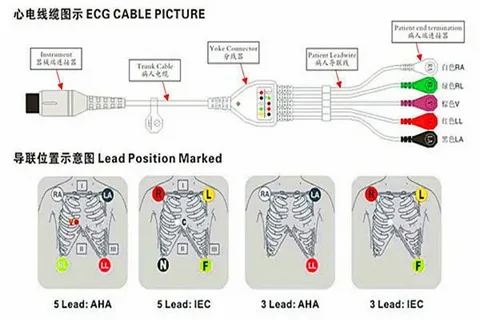Electrocardiograms (ECGs or EKGs) are a cornerstone of cardiac monitoring—but the quality of your readings depends on more than just the machine. One of the most overlooked components in this process? The ECG leadwires.
These small yet crucial accessories act as the connection between your patient and your monitor. And when they’re not working properly—whether due to damage, poor quality, or compatibility issues—it can compromise everything from real-time analysis to long-term diagnosis.
Let’s take a closer look at why ECG leadwires matter, how to choose the right ones, and what features to prioritize.
What Are ECG Leadwires?
ECG leadwires are the cables that connect electrodes on the patient’s skin to the ECG monitor. Each wire picks up electrical signals from specific parts of the body and transmits them to the device for interpretation.
Together, they give you the heart’s electrical blueprint—used for detecting arrhythmias, heart attacks, and other critical conditions.
How ECG Leadwires Work
Here’s the simple version:
- Electrodes are placed on the patient’s body (chest, arms, legs).
- These electrodes detect the electrical activity generated by the heart.
- ECG leadwires carry those signals to the monitor.
- The monitor then interprets the signals and displays the waveform.
No leadwire, no signal. And a poor-quality leadwire? That’s a recipe for noise, artifacts, or even failed readings.
Types of ECG Leadwires
Not all leadwires are created equal. Some of the most common variations include:
- 3-Lead, 5-Lead, and 12-Lead Systems – The number of leads depends on the clinical application.
- Snap vs. Clip Style – Some wires use snaps; others use pinch-clips to connect to electrodes.
- Disposable vs. Reusable – Reusable wires are more common in general hospital use, while disposables are ideal in infection-control zones.
The configuration you choose should depend on patient risk, mobility, and monitoring duration.
Common Issues with ECG Leadwires
Faulty ECG readings are often caused by damaged or poorly maintained leadwires. Some signs include:
- Excessive noise or artifact on the ECG
- Intermittent signal loss
- Discoloration or stiffness in the cables
- Loose or broken connectors
If your staff is spending time troubleshooting leads during procedures, that’s a red flag.
What to Look for in High-Quality Leadwires
Choosing reliable ecg leadwires isn’t just about compatibility—it’s about safety and signal quality.
Here’s what to check for:
- Shielded cables to reduce electrical interference
- Latex-free and biocompatible materials
- Clear labeling for quick identification
- Secure connection ends that don’t loosen over time
- Flexibility for patient comfort and mobility
And of course, ensure the leadwires are FDA-cleared or CE-certified for medical use.
Maintenance and Storage Tips
Even high-end leadwires won’t last long if they’re not properly maintained. Here are a few best practices:
- Wipe down after each use with compatible cleaning agents
- Avoid kinking during storage
- Inspect weekly for cracks, fraying, or stiffness
- Replace regularly based on usage volume and hospital protocol
A damaged leadwire can cause a false alarm—or worse, a missed one.
Compatibility Matters
Not every wire fits every monitor. Always verify compatibility with your specific model (GE, Philips, Nihon Kohden, etc.) before purchasing. Some systems use proprietary connectors that require matching lead sets.
When in doubt, refer to the manufacturer’s documentation—or source wires from a trusted biomedical supplier.
Where to Buy ECG Leadwires Online
Need to source dependable, hospital-grade ecg leadwires that work across leading brands? The Biomed Guys offers a wide selection of reusable and disposable ECG cables that prioritize signal clarity, durability, and patient safety.
Whether you’re outfitting a cardiac care unit or just need to replace faulty wires, they’ve got you covered.
Final Thoughts
ECG leadwires may be small, but their role is anything but minor. For clinicians, biomedical engineers, and hospital buyers, understanding what makes a good leadwire can improve the accuracy of every ECG reading—and the quality of every diagnosis that follows.
Invest in quality. Inspect often. And don’t ignore the little things—they could be delivering a big message from the patient’s heart.

